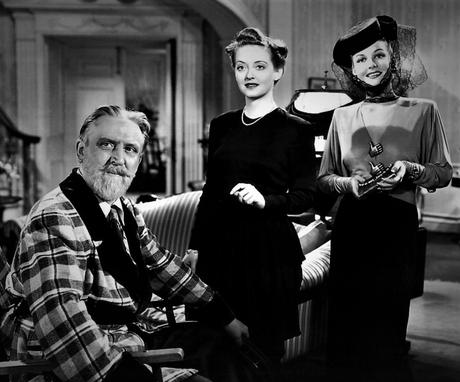
If you were a movie fan in late 1941 and early 1942, heading out to the local theater had to feel like a gift from Hollywood — particularly if you were fond of comedies. Between December 1941 and January 1942, Ball of Fire and Sullivan’s Travels both hit the big screen for the first time. And for those who were feeling the Christmas spirit — even a little bit after the holidays — there was The Man Who Came to Dinner.
The Man Who Came to Dinner premiered in Atlantic City on Christmas Eve 1941 and went into wide release in January 1942. Before it was a hit movie, it was a hit Broadway comedy written by George S. Kaufman and Moss Hart, who drew inspiration from the time Hart unexpectedly found himself hosting drama critic Alexander Wollcott at his home. The play also featured a slew of supporting characters based on other big personalities who were part of Wollcott’s inner circle, including Gertrude Lawrence (inspiration for Lorraine Sheldon), Noel Coward (inspiration for Beverly Carlton), and Harpo Marx (inspiration for Banjo.) While Alexander Wollcott was offered the chance to star in the show as Sheridan Whiteside, he was unable to accept and the part went to Monty Woolley instead.
The original Broadway production of The Man Who Came to Dinner ran for 739 performances between October 16, 1939 and July 12, 1941. Among the people who saw the play during that time was Bette Davis. Bette immediately saw the potential for turning it into a film and liked the idea of playing Maggie Cutler, secretary to Sheridan Whiteside. Fittingly, the original Broadway run of The Man Who Came to Dinner closely coincided with what was the height of Bette’s career. By the time the film version of The Man Who Came to Dinner went into production, Bette was a two-time Academy Award winner who was just coming off of movies like The Letter and Dark Victory, and still had Now, Voyager and In This Our Life ahead of her. She was truly the reigning queen of Warner Brothers and wasn’t afraid to speak up about the projects she wanted to work on and who she wanted to work with.
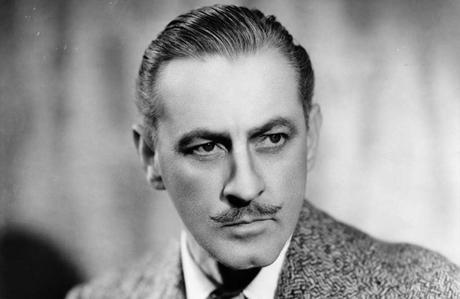
In Whitney Stine’s 1978 book Mother Goddam: The Story of the Career of Bette Davis, which includes commentary from Bette herself, Stine wrote that when Bette saw the play, she specifically wanted to do the movie version with John Barrymore starring as Sheridan Whiteside. She convinced Jack Warner to buy the film rights to the play and John Barrymore did film a screen test for it. However, at this point in his life, Barrymore was notorious for having difficulties remembering his lines. He heavily relied on cue cards and was known to ad-lib and go off on tangents. Ultimately, Warner Brothers said no to Barrymore, much to Bette’s disappointment. Bette said of it, “I’d take Barrymore’s adlibbing rather than make the film with anyone else.” That sentiment largely shaped Bette’s opinion of the movie overall, saying, “I felt the film was not directed in a very imaginative way. For me, it was not a happy movie to make — that it was a success, of course, did make me happy. I guess I never got over my disappointment in not working with the great John Barrymore.”
Even though Monty Woolley originated the role of Sheridan Whiteside on Broadway, he wasn’t the first person the studio went to when they decided to pass on John Barrymore. Woolley wasn’t a complete unknown to movie audiences, but any work he had done in movies was in supporting roles. On the other hand, Cary Grant was very popular with audiences, with movies like The Philadelphia Story, Gunga Din, and The Awful Truth among his then-recent hits. Warner Brothers not only tried to get Cary Grant to star as Sheridan Whiteside, The Man Who Came to Dinner came close to being a full-on His Girl Friday reunion. The February 4, 1941 issue of The Film Daily included an item which stated Warners was close to signing Cary Grant and Rosalind Russell for The Man Who Came to Dinner, with Howard Hawks set to direct.
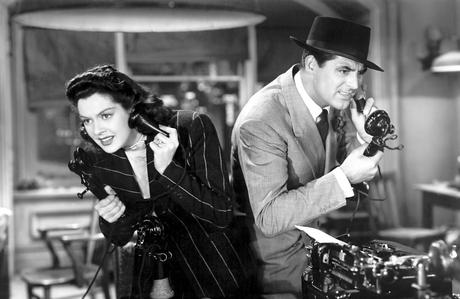
While Rosalind Russell didn’t pan out, Cary Grant was associated with the movie a bit longer. In their March 28, 1941 issue, Motion Picture Daily published an item reporting that Cary Grant had been signed by Warner Brothers to play the lead in The Man Who Came to Dinner and that Cary’s salary would be donated to British war relief. (It also appears the movie’s director had changed by this point. This same item also mentioned Edmund Goulding being attached to direct, but it ended up being directed by William Keighley, who was confirmed in June 1941.) But by early April 1941, Cary was officially out as Sheridan Whiteside. An item published in the April 10, 1941 issue of The Film Daily reported he was going to do Bedtime Story at Columbia instead of The Man Who Came to Dinner. (Bedtime Story ended up going to Fredric March instead.)
In addition to Cary Grant and John Barrymore, other actors reported to be considered for Sheridan Whiteside include Orson Welles, Charles Laughton, Laird Cregar, Robert Benchley, and Fredric March. In searching through old movie magazines and film industry trade publications, I was able to find specific references to Fredric March and Charles Laughton in association with the movie. The February 22, 1941 issue of Film Bulletin mentioned Warner Brothers being in talks with Fredric March for both The Man Who Came to Dinner and One Foot in Heaven, the latter being a movie he did end up making. Charles Laughton reportedly desperately wanted to play Sheridan Whiteside, but his first test did not go well. Laughton’s agent convinced producer Hal B. Wallis to give Charles another chance, but according Wallis, the second test ended up being worse than the first.
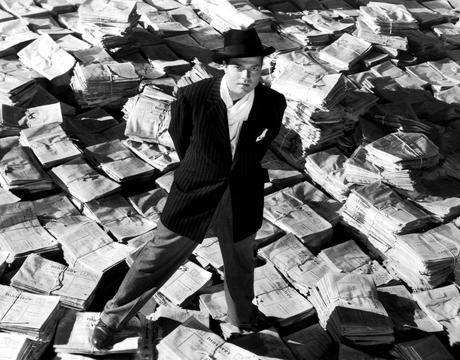
CITIZEN KANE, Orson Welles, 1941, astride stacks of newspaper
" data-image-title="MBDCIKA EC019" data-orig-file="https://hollywoodrevue.files.wordpress.com/2023/12/annex-welles-orson-citizen-kane_02.jpg" data-image-meta="{"aperture":"0","credit":"Everett Collection","camera":"","caption":"CITIZEN KANE, Orson Welles, 1941, astride stacks of newspaper","created_timestamp":"0","copyright":"\u00a9Everett Collection \/ Everett Collection","focal_length":"0","iso":"0","shutter_speed":"0","title":"MBDCIKA EC019","orientation":"1"}" width="1024" data-medium-file="https://hollywoodrevue.files.wordpress.com/2023/12/annex-welles-orson-citizen-kane_02.jpg?w=300" loading="lazy" data-permalink="https://hollywoodrevue.wordpress.com/2023/12/11/casting-the-man-who-came-to-dinner-1941/mbdcika-ec019/" alt="Orson Welles in Citizen Kane." height="802" srcset="https://hollywoodrevue.files.wordpress.com/2023/12/annex-welles-orson-citizen-kane_02.jpg?w=1024 1024w, https://hollywoodrevue.files.wordpress.com/2023/12/annex-welles-orson-citizen-kane_02.jpg?w=2048 2048w, https://hollywoodrevue.files.wordpress.com/2023/12/annex-welles-orson-citizen-kane_02.jpg?w=150 150w, https://hollywoodrevue.files.wordpress.com/2023/12/annex-welles-orson-citizen-kane_02.jpg?w=300 300w, https://hollywoodrevue.files.wordpress.com/2023/12/annex-welles-orson-citizen-kane_02.jpg?w=768 768w" class="wp-image-12167" data-large-file="https://hollywoodrevue.files.wordpress.com/2023/12/annex-welles-orson-citizen-kane_02.jpg?w=620" />I couldn’t find any mentions of Orson Welles or Laird Cregar being considered for the film version of The Man Who Came to Dinner in any trade publications from the era, but they each had chances to play Sheridan Whiteside in other productions. Laird Cregar played the part in a stage production in 1941. As for Orson Welles, he had been offered the chance to play Sheridan in the original Broadway production, which he turned down because of the time commitment it would require. In 1972, he ended up playing Sheridan in an updated, made-for-TV production of the play, which also starred Lee Remick, Don Knotts, and Joan Collins.
Even though other actors had been considered for the part, it seems like it would have been an uphill battle for any of them to top Cary Grant in the eyes of the studio. In the item announcing the casting of Cary Grant in the April 5, 1941 issue of Film Bulletin, they wrote: “There’s no doubt about it — movie-goers prefer their heroes young and handsome, so after testing Charles Laughton and character actors for the role, Cary Grant has been signed for ‘The Man Who Came to Dinner.’ This was the original plan of Warner Brothers executives.” After Cary left the project, Monty Woolley was announced in July 1941.
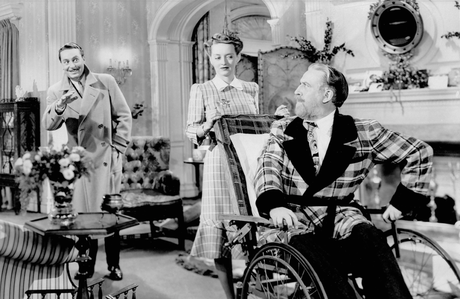
Even though Bette Davis lobbied for The Man Who Came to Dinner, she wasn’t necessarily the only one who was considered for the part of Maggie. In the November 6, 1940 issue of Variety, a brief item was published about Mary Wickes being the first member of the Broadway cast to agree to reprise their role for the film. This item also mentioned Edith Atwater, who originated Maggie Cutler on Broadway, being under consideration for the movie as well. Aside from Rosalind Russell, other actresses reportedly considered for the part included Myrna Loy, Jean Arthur, and Olivia de Havilland. But if they were considered, it doesn’t seem to have reached the point that there was enough buzz for trade publications or fan magazines to write about it.
While Bette didn’t get her first choice actor for Sheridan Whiteside, she was more successful in influencing casting the part of Bert Jefferson, Maggie’s love interest. Bert Jefferson was played by Richard Travis, a name that likely doesn’t ring many bells today. The Man Who Came to Dinner was his first major film role and it ended up being his best remembered movie. Prior to The Man Who Came to Dinner, Richard Travis had mostly been acting in uncredited roles. But, according to a story told during promotion for the movie, Bette Davis saw him in the short Here Comes the Cavalry when she went to a theater for a screening of The Bride Came C.O.D. Bette was impressed enough by him that she suggested the studio have him try out for the part of Bert Jefferson.

The fact that Bette Davis had a hand in getting Richard Travis cast in The Man Who Came to Dinner ended up being part of the the process of building him up as a rising star. Some fan magazines published entire articles about how he was discovered by Bette Davis. More often, it was only briefly mentioned. For example, in the November 1941 issue of Photoplay, Richard Travis was mentioned in the “Cal York’s Inside Stuff” column, which read: “Richard Travis, discovered by Bette Davis and placed in ‘The Man Who Came to Dinner’ cast, is causing many a backward glance among the young and beautiful. Watch for him.”
Aside from The Man Who Came to Dinner, Richard Travis appeared in The Big Shot with Humphrey Bogart and Mission to Moscow with Walter Huston. Since Cary Grant had been set to star in The Man Who Came to Dinner, it’s interesting that Richard Travis was, at one point, set to appear in Arsenic and Old Lace. The August 20, 1941 issue of The Film Daily mentioned that Richard Travis was the first actor signed for Arsenic, although it didn’t mention which role he was supposed to play.
Not long after his film career was getting started, Richard Travis went into the military in service of World War II. The July 17, 1943 issue of Showmen’s Trade Review reported that he was a private in the Army Air Force stationed in Kearn, Utah. During his time in the Air Force, he had the chance to get involved with another project linked to Moss Hart, the play Winged Victory. Winged Victory focused on the lives of Air Force recruits going through training and was produced as a fundraiser for the Army Emergency Relief Fund. The play was a Broadway hit and, in addition to Richard Travis, the show featured many other Air Force members who were either part of the entertainment industry or would later be in the industry, including Karl Malden, George Reeves, Gary Merrill, Red Buttons, Mario Lanza, and Lee J. Cobb.
After his time in the Air Force, Richard Travis continued acting in film and television, making his last appearance in Cyborg 2087 in 1966. After retiring from acting, he became a real estate under his birth name, William Justice. While he’s an actor who doesn’t have the biggest name recognition today, he still made a welcome addition to a holiday classic.
